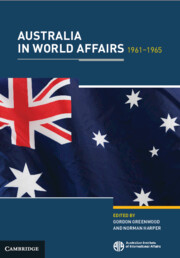Book contents
- Frontmatter
- Preface
- Contents and Contributors
- I Australian Foreign Policy in Action
- II The Australian Diplomatic Service 1935–1965
- III Economic Policies
- IV The United Nations
- V Australian Defence, 1945–1965
- VI Australia and the United States
- VII Australia and Japan, 1961–1965
- VIII Australian Policy Towards China, 1961–1965
- IX Australia and the Indian Ocean Area, 1961–1965
- X Papua-New Guinea, 1961–1965
- XI The South Pacific Commission
- Index
- Plates
VI - Australia and the United States
(With Special Reference to South-East Asia)
Published online by Cambridge University Press: 29 March 2024
- Frontmatter
- Preface
- Contents and Contributors
- I Australian Foreign Policy in Action
- II The Australian Diplomatic Service 1935–1965
- III Economic Policies
- IV The United Nations
- V Australian Defence, 1945–1965
- VI Australia and the United States
- VII Australia and Japan, 1961–1965
- VIII Australian Policy Towards China, 1961–1965
- IX Australia and the Indian Ocean Area, 1961–1965
- X Papua-New Guinea, 1961–1965
- XI The South Pacific Commission
- Index
- Plates
Summary
In formulating its foreign policy any country tends to distinguish between areas of central and of peripheral importance, between those areas where it can exert considerable influence and those where it can exert little influence. This is the choice facing small and middling countries like Australia. The great powers have to make similar choices to conserve their resources – political, economic and diplomatic – but are still able to exert considerable or even overwhelming power from time to time in areas which are normally peripheral but which may, because of shifts in the power balance, become less peripheral and more central from the point of view of global policies.
Keywords
- Type
- Chapter
- Information
- Australia in World Affairs 1961–1965 , pp. 313 - 376Publisher: Cambridge University PressFirst published in: 2024

